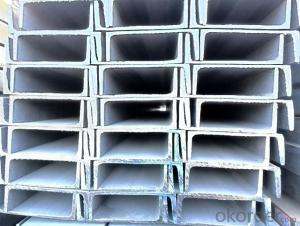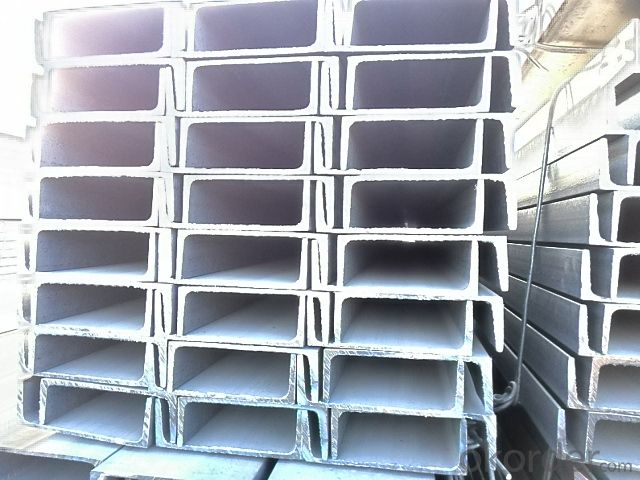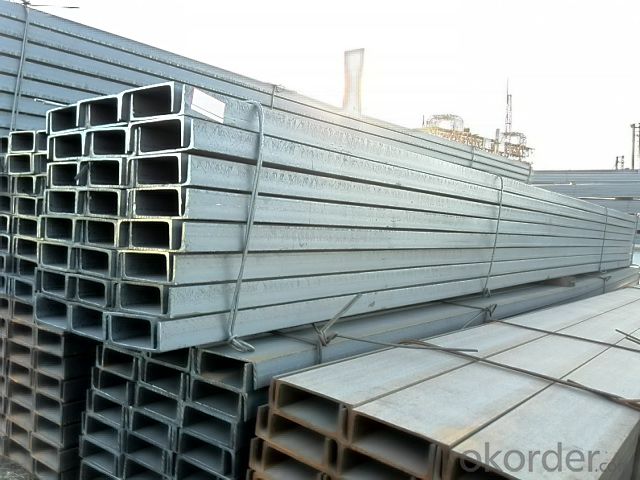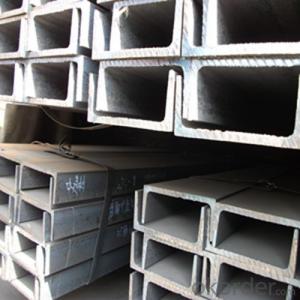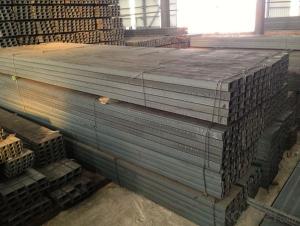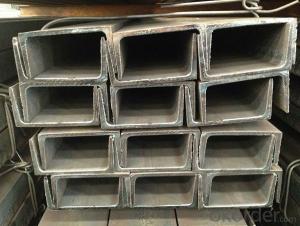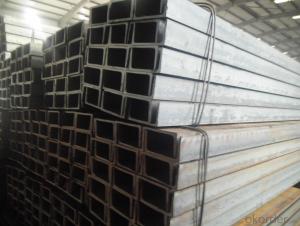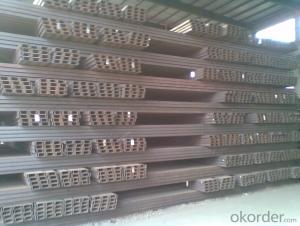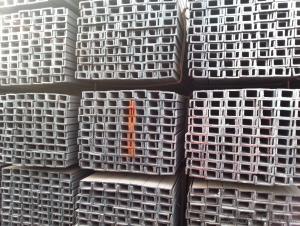JIS U Channels for Structures Buildings Making
- Loading Port:
- Tianjin
- Payment Terms:
- TT OR LC
- Min Order Qty:
- 25 m.t
- Supply Capability:
- 10000 m.t/month
OKorder Service Pledge
OKorder Financial Service
You Might Also Like
Product Description:
| Minimum Order Quantity: | 25MT | Unit: | m.t. | Loading Port: | Xingang Port |
| Supply Ability: | 120000TON/Year | Payment Terms: | TT or LC |
Product Applications:
Japanese Standard U-channels are ideal for structural applications and are widely used in the construction of buildings and bridges, and the manufacturing, petrochemical, and transportation industries.
Product Advantages:
OKorder's Japanese Standard U-channels are durable, strong, and resist corrosion.
Main Product Features:
· Premium quality
· Prompt delivery & seaworthy packing (30 days after receiving deposit)
· Corrosion resistance
· Can be recycled and reused
· Mill test certification
· Professional Service
· Competitive pricing
Product Specifications:
Manufacture: Hot rolled
Grade: Q195 – 235
Certificates: ISO, SGS, BV, CIQ
Length: 6m – 12m, as per customer request
Packaging: Export packing, nude packing, bundled
1. We are definitely speciallizing in manufacturing and supplying channel steel as per japanese standard, which is characterised with high mechanical strength and competitive prices.
Original Place | Tangshan, China | Brand Name | UINDA |
Standard | JIS G3192 : 1990 | ||
Material Grade | SS490 | ||
Sizes | 50mm to 200mm | ||
Sales Volume/Year | 3000MT | ||
Destination Area | Middle East, Africa, Southeast Asia | ||
2. The sections in details are as followings in the table-1
JIS U CHANNEL | Standard | Sectional | Dimension |
| Mass: |
| (mm) | (mm) | (mm) | (mm) |
|
50x25 | 50 | 25 | 3.0 | 6.00 | 2.37 |
75X40 | 75 | 40 | 3.8 | 7.00 | 5.30 |
75X40 | 75 | 40 | 4.0 | 7.00 | 5.60 |
75X40 | 75 | 40 | 4.5 | 7.00 | 5.85 |
75X40 | 75 | 40 | 5.0 | 7.00 | 6.92 |
|
|
|
|
|
|
100X50 | 100 | 50 | 3.8 | 6.00 | 7.30 |
100X50 | 100 | 50 | 4.2 | 6.00 | 8.03 |
100X50 | 100 | 50 | 4.5 | 7.50 | 8.97 |
100X50 | 100 | 50 | 5.0 | 7.50 | 9.36 |
|
|
|
|
|
|
125X65 | 125 | 65 | 5.2 | 6.80 | 11.66 |
125X65 | 125 | 65 | 5.3 | 6.80 | 12.17 |
125X65 | 125 | 65 | 5.5 | 8.00 | 12.91 |
125X65 | 125 | 65 | 6.0 | 8.00 | 13.40 |
|
|
|
|
|
|
150x75 | 150 | 75 | 5.5 | 7.30 | 14.66 |
150x75 | 150 | 75 | 5.7 | 10.00 | 16.71 |
150x75 | 150 | 75 | 6.0 | 10.00 | 17.90 |
150x75 | 150 | 75 | 6.5 | 10.00 | 18.60 |
150x75 | 150 | 75 | 6.5 | 10.00 | 24.00 |
|
|
|
|
|
|
200X80 | 200 | 80 | 7.5 | 11.00 | 24.60 |
Table-1
3. The mechanical property of JIS U Channel Steel in the table-2:
Grade | Yield Strength,N/mm² | Extension Strength N/mm² | |||
Thickness of Steel,mm | |||||
≦16 | >16-≦40 | >40-≦100 | >100 | ||
SS490 | ≧285 | ≧275 | ≧255 | ≧245 | 490-610 |
Table-2
4. The chemical composition of JIS U Channel Steel as per SS490 in the table-3
Grade | Element(%) | |||
C | Mn | P | S | |
SS490 | - | - | ≦0.050 | ≦0.050 |
Table-3
FAQ:
Q1: Why buy Materials & Equipment from OKorder.com?
A1: All products offered byOKorder.com are carefully selected from China's most reliable manufacturing enterprises. Through its ISO certifications, OKorder.com adheres to the highest standards and a commitment to supply chain safety and customer satisfaction.
Q2: How do we guarantee the quality of our products?
A2: We have established an advanced quality management system which conducts strict quality tests at every step, from raw materials to the final product. At the same time, we provide extensive follow-up service assurances as required.
Q3: The products are invoicing on theoritical weight or on actual weight?
A3: We can do it in both manners, according to the customers' request.
Images:

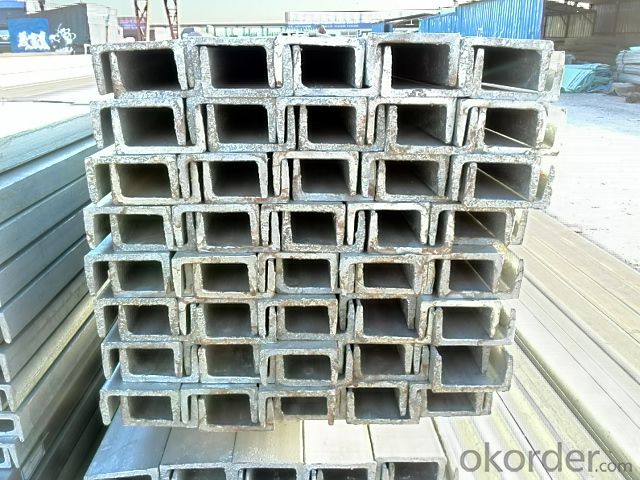
- Q: What are the methods and the price of building the floor?
- Channel or I-beam construction. Under normal circumstances, the use of channel steel on the line, but with the bending strength of I-beam will be higher, of course, the cost will be higher, but also occupy more space I-beam height. The advantage of channel steel construction is that it is quick to use. It does not need to wait. The disadvantage is that the channel made attic, when people walk in the above, there will be a certain shaking sound, the smaller channel specifications, the greater the shaking. The adoption of channel steel is a recommended practice.
- Q: Can steel channels be used for marine applications?
- Yes, steel channels can be used for marine applications. Steel channels are versatile structural components that are commonly used in shipbuilding and other marine-related industries. They offer excellent strength and durability, making them suitable for various marine applications such as ship hulls, decks, bulkheads, and frames. The corrosion resistance of steel channels can be enhanced through the use of proper coatings and treatments, making them capable of withstanding harsh marine environments. Additionally, steel channels can be easily fabricated and welded to meet specific design requirements, making them a preferred choice in marine construction.
- Q: Are steel channels prone to rusting?
- Yes, steel channels are prone to rusting. Steel is primarily made of iron, and when exposed to moisture or oxygen, it can undergo a chemical reaction known as oxidation, which leads to the formation of rust. Rusting weakens the steel structure, making it more susceptible to corrosion and eventual failure. Therefore, steel channels need to be protected from moisture and other corrosive elements using appropriate coatings or treatments to prevent rust formation and prolong their lifespan.
- Q: Can steel channels be used for creating signage or display structures?
- Yes, steel channels can be used for creating signage or display structures. Steel channels are durable, strong, and versatile, making them suitable for supporting and framing various types of displays and signage. Additionally, their structural integrity allows for customization and the ability to handle heavier loads, making them a popular choice for creating robust and long-lasting signage or display structures.
- Q: Do steel channels have any specific thermal conductivity properties?
- Yes, steel channels have specific thermal conductivity properties. Steel is known to have a relatively high thermal conductivity compared to other materials, meaning it can transfer heat more easily. This property makes steel channels effective in dissipating heat and maintaining temperature stability in various applications such as HVAC systems, heat exchangers, and electrical enclosures.
- Q: Are steel channels suitable for airport construction projects?
- Yes, steel channels are suitable for airport construction projects. Steel channels offer high strength, durability, and resistance to corrosion, making them ideal for supporting heavy loads and withstanding harsh weather conditions. Additionally, steel channels can be easily fabricated, installed, and integrated into various airport infrastructure components, such as runways, hangars, and terminal buildings.
- Q: How to connect channel steel and round steel?
- End face of channel steel and end face of round steel:Can first welding a large circular steel plate and steel bar etc. in the channel to the end faces of the circular plate thickness should be more than 10mm, then the circular plate side angle steel and round steel bar to coincide welding, chamfering, need full welding between the two.
- Q: Do steel channels require any special maintenance?
- Steel channels do not require any special maintenance. However, regular maintenance is necessary to ensure their longevity and performance. This maintenance typically includes cleaning and inspecting the channels for any signs of damage or corrosion. If any issues are identified, they should be promptly addressed to prevent further deterioration. Additionally, lubricating the channels regularly can help reduce friction and wear, ensuring smooth operation. By following these maintenance practices, steel channels can remain in optimal condition and provide reliable support and structural integrity.
- Q: What are the different types of accessories used with steel channels in construction?
- There are several different types of accessories used with steel channels in construction, including brackets, connectors, clamps, and fasteners. These accessories are used to secure the steel channels in place, connect them to other structural components, provide additional support, and enhance their overall functionality.
- Q: Can steel channels be used for shelving systems?
- Yes, steel channels can be used for shelving systems. Steel channels are strong and durable, making them suitable for supporting heavy loads. They can be easily attached to walls or other structures to create a stable and sturdy shelving system. Additionally, steel channels come in various sizes and lengths, allowing for customization to fit different storage needs. Overall, steel channels are a popular choice for shelving systems in warehouses, garages, and other industrial settings due to their strength and versatility.
Send your message to us
JIS U Channels for Structures Buildings Making
- Loading Port:
- Tianjin
- Payment Terms:
- TT OR LC
- Min Order Qty:
- 25 m.t
- Supply Capability:
- 10000 m.t/month
OKorder Service Pledge
OKorder Financial Service
Similar products
Hot products
Hot Searches
Related keywords
